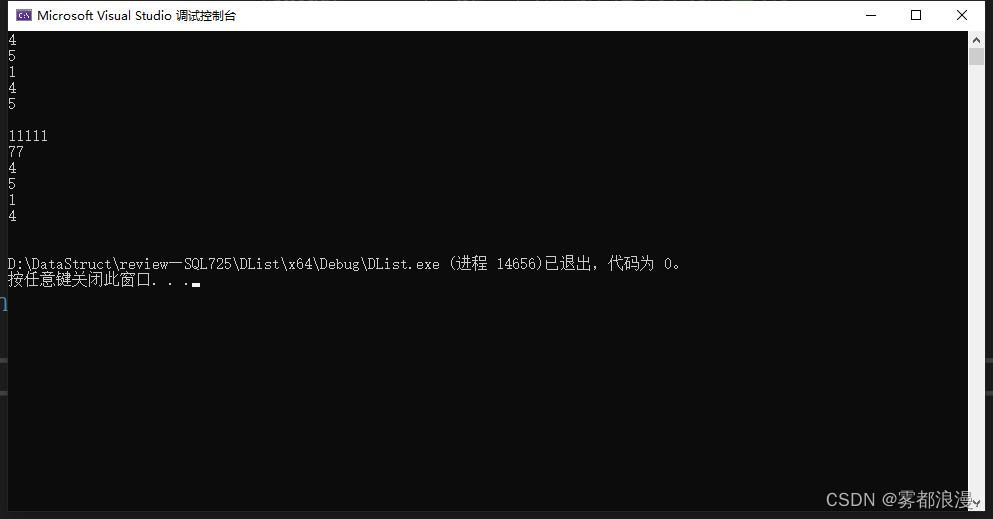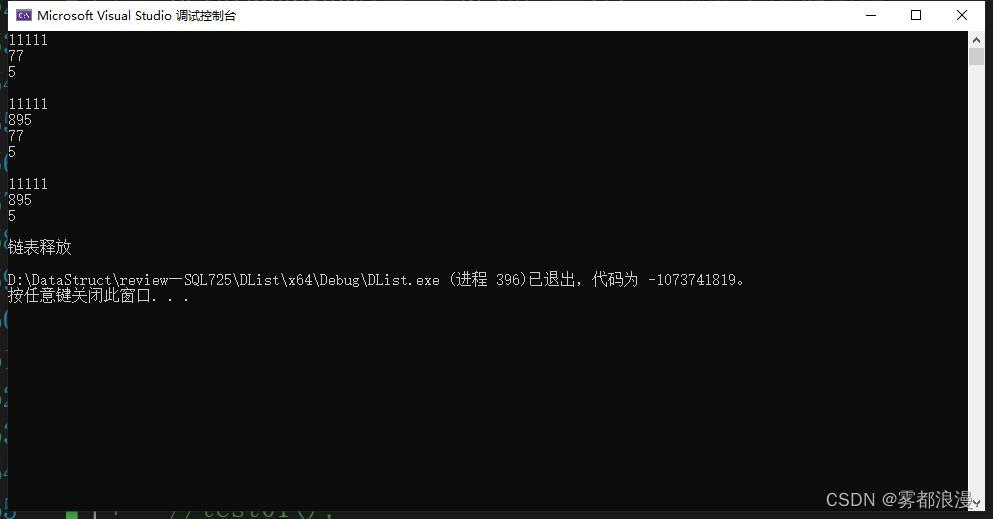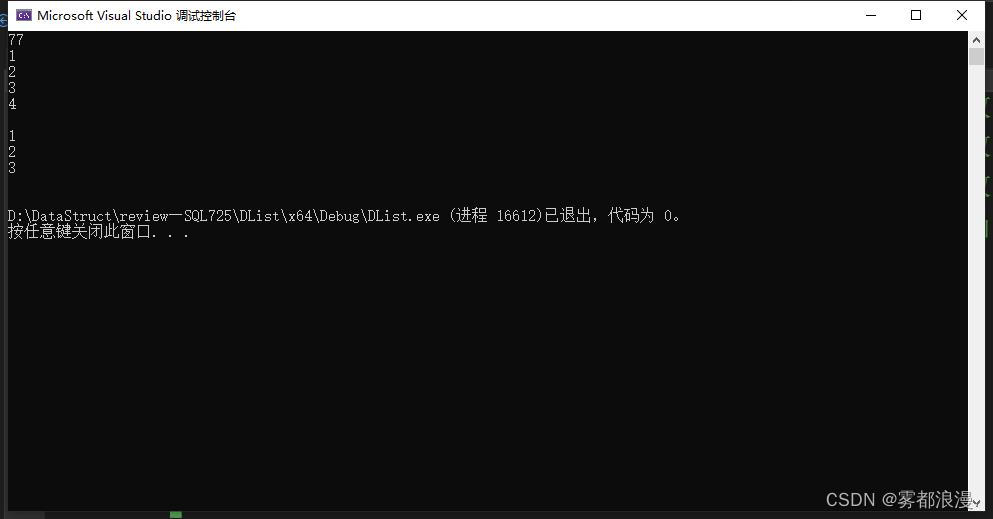目录
1、在单链表的基础上,进行了双链表的学习;
双链表与单链表最大的区别就是结构具有很大的优势,我们在进行删除、查找、插入等功能的时候,更加的方便快捷;
2、头文件,对结构体进行定义以及函数的声明;
#pragma once
#include <stdio.h>
#include <stdlib.h>
#include <assert.h>
typedef int DListDataType;
typedef struct DListNode
{
DListDataType data;
struct DList* next;
struct DList* prev;
}DLNode;
DLNode* DListIint();//双向链表循环初始化
void DListDestroy(DLNode* phead);//双链表摧毁函数
void DListPrint(DLNode* phead);//链表打印函数
DLNode* BuyListNode(DListDataType x);//链表新节点创建函数
void DListPushBack(DLNode* phead, DListDataType x);//链表尾插函数
void DListPopBack(DLNode* phead);//链表尾删函数
void DListPushFront(DLNode* phead, DListDataType x);//链表头插函数
void DListPopFront(DLNode* phead);//链表头删函数
DLNode* DListFind(DLNode* phead, DListDataType x);//链表查找函数
void DListInsert(DLNode* pos, DListDataType x);//链表插入函数
void DListErase(DLNode* pos);//删除pos位置
3、对各个功能子函数进行编写;
#include "DList.h"
//双向链表初始化函数
DLNode* DListIint()
{
DLNode* phead = (DLNode*)malloc(sizeof(DLNode));//创建哨兵位头结点
phead->next = phead;//链表双向循环初始化
phead->prev = phead;
return phead;
}
//********************************************
//链表打印函数
void DListPrint(DLNode* phead)
{
assert(phead);
DLNode* cur = phead->next;
while (cur != phead)
{
printf("%d\n", cur->data);
cur = cur->next;
}
printf("\n");
}
//********************************************
//链表新节点创建函数
DLNode* BuyListNode(DListDataType x)
{
DLNode* newnode = (DLNode*)malloc(sizeof(DLNode));
newnode->next = NULL;
newnode->prev = NULL;
newnode->data = x;
return newnode;
}
//********************************************
//链表尾插函数
void DListPushBack(DLNode* phead, DListDataType x)
{
assert(phead);
/*DLNode* tail = phead->prev;
DLNode* newnode = BuyListNode(x);
tail->next = newnode;
newnode->prev = tail;
phead->prev = newnode;
newnode->next = phead;*/
DListInsert(phead, x);//链表插入函数
}
//********************************************
//链表尾删函数
void DListPopBack(DLNode* phead)
{
assert(phead);
assert(phead->next != phead);
/*DLNode* tail = phead->prev;
DLNode* pervtail = tail->prev;
pervtail->next = phead;
phead->prev = pervtail;
free(tail);*/
DListErase(phead->prev);
}
//********************************************
//链表头插函数
void DListPushFront(DLNode* phead, DListDataType x)
{
assert(phead);
/*DLNode* newnode = BuyListNode(x);
DLNode* Next = phead->next;
phead->next = newnode;
newnode->prev = phead;
newnode->next = Next;
Next->prev = newnode;*/
DListInsert(phead->next,x);
}
//********************************************
//链表头删函数
void DListPopFront(DLNode* phead)
{
assert(phead);
assert(phead->next != phead);
/*DLNode* Next = phead->next;
DLNode* Nextnext = Next->next;
phead->next = Nextnext;
Nextnext->prev = phead;
free(Next);*/
DListErase(phead->next);
}
//********************************************
//链表查找函数
DLNode* DListFind(DLNode* phead, DListDataType x)
{
assert(phead);
DLNode* cur = phead->next;
while (cur != phead)
{
if (cur->data == x)
{
return cur;
}
else
{
cur = cur->next;
}
}
return NULL;
}
//********************************************
//链表插入函数pos位置之前
void DListInsert(DLNode* pos, DListDataType x)
{
assert(pos);
DLNode* newnode = BuyListNode(x);
DLNode* posprev = pos->prev;
posprev->next = newnode;
newnode->prev = posprev;
newnode->next = pos;
pos->prev = newnode;
}
//********************************************
//删除pos位置
void DListErase(DLNode* pos)
{
assert(pos);
DLNode* posnext = pos->next;
DLNode* posprev = pos->prev;
posprev->next = posnext;
posnext->prev = posprev;
free(pos);
pos = NULL;
}
//********************************************
//双链表摧毁函数
void DListDestroy(DLNode* phead)
{
assert(phead);
DLNode* cur = phead->next;
while (cur != phead)
{
DLNode* NEXT = cur->next;
free(cur);
cur = NEXT;
}
free(phead);
phead = NULL;
}
//********************************************4、进行各个子程序功能测试 ;
4.1测试结果1
void test01()
{
DLNode* PList = DListIint();
DListPushBack(PList, 4);
DListPushBack(PList, 5);
DListPushBack(PList, 1);
DListPushBack(PList, 4);
DListPushBack(PList, 5);// 链表尾插函数
DListPrint(PList);
DListPopBack(PList);// 链表尾删函数
DListPushFront(PList, 77);//链表头插函数
DListPushFront(PList, 11111);
DListPrint(PList);
}1)进行链表基础的插入和删除功能验证;首先进行尾插,数据(45145);
2)然后尾删掉一个(5),再头插)(11111、77),成功运行如下图;

4.2测试结果2
void test02()
{
DLNode* PList = DListIint();
DListPushBack(PList, 5);// 链表尾插函数
DListPushFront(PList, 77);//链表头插函数
DListPushFront(PList, 11111);
DListPrint(PList);
DLNode* pos = DListFind(PList,77);
if (pos)
{
DListInsert( pos, 895);//链表插入函数
DListPrint(PList);
DListErase(pos);//删除pos位置
DListPrint(PList);
DListDestroy(PList);//双链表摧毁函数
printf("链表释放\n");
DListPrint(PList);
}
else
printf("链表没有该数据\n");
}1)进行查找函数和插入函数的验证,先插入数据11111、77、5;
2)然后查找链表中的77,找到了就插入895;
3)然后进行pos位置的删除,把77删除;
4)最后验证链表摧毁函数的验证,把链表给释放了;

4.3测试结果3
void test03()
{
DLNode* PList = DListIint();
DListPushBack(PList,1);// 新链表尾插函数
DListPushBack(PList,2);// 新链表尾插函数
DListPushBack(PList,3);// 新链表尾插函数
DListPushBack(PList,4);// 新链表尾插函数
DListPushFront(PList, 77);//新链表头插函数
DListPrint(PList);
DListPopBack(PList);// 新链表尾删函数
DListPopFront(PList);//新链表头删函数
DListPrint(PList);
}1)对尾插和头插,插入函数进行了优化,通过调用插入函数Insert函数进行优化,方便快捷;
2)对尾删和头删,删除函数进行了优化,通过调用删除函数Erase函数进行优化,方便快捷;






















 74
74











 被折叠的 条评论
为什么被折叠?
被折叠的 条评论
为什么被折叠?








